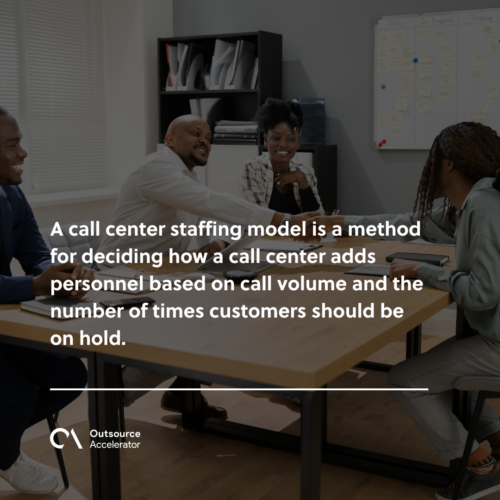Staffing Model
Definition
What is a staffing model?
A call center staffing model is a method for deciding how a call center adds personnel based on call volume and the number of times customers should be on hold. This model may also account for post-call work and breaks.
Although outsourcing all or part of your company’s call center staffing can be a fully managed process, you must first determine which appropriate staffing model is beneficial to the organization.
Call center staffing models will assist in determining how many employees are required based on call volume and service level requirements.
Outsourcing, insourcing, location-specific suppliers, live agents, and self-help customer service technology are among the most popular call center staffing models.
The staffing model ensures people are in suitable positions to maximize efficiency and productivity. It also helps to ensure the organization has the right hiring process to recruit the right employees (either temporary or permanent, to meet its goals and objectives).
In context, temporary employees can allow the organization to fill in for permanent employees on leave or additional support during peak periods.
While permanent employees give the organization stability and continuity to meet its goals and objectives.
A successful staffing model also helps confirm the organization can fill its staffing needs, save labor costs, and prioritize employee retention.
By clearly understanding each employee’s roles and responsibilities, the organization and its hiring managers can ensure that it can attract and retain the best talent, especially in a tight labor market.

Essential call center staffing model elements
Based on call arrival results, a staffing model predicts how many people will be required to achieve a target.
The following elements are essential for developing an accurate and effective staffing model:
- Interval calls. The number of calls available by the hour, half-hour, or fifteen minutes.
- Interval average handle time. It is calculated by dividing the total talk time plus the total wrap time by the number of calls addressed during the interval.
- Shrinkage. It is the number of employees who will be doing jobs other than answering phones.
Different staffing models
Various staffing models can be used to ensure that the skill gaps are filled. They help guarantee the right people are in the right parts so the organization’s strategic goals are achieved.
Below are some of the most common staffing models used for external recruitment efforts:
- Traditional model – It is often used in larger organizations, allowing for more efficient use of resources for the company’s future needs.
- Matrix model – This model is based on the idea that the organization should have a certain number of people in each role. This is one of the flexible staffing models.
- In connection, this staffing model is often used in smaller organizations, allowing for more creativity. However, this model can be challenging to maintain, as it requires a lot of communication and teamwork.
- Project-based model – This is often used in larger organizations, allowing for more efficient use of resources and other critical needs. It commonly involves outsourced employees who take over various job duties and other managed services.
- Virtual model – It is used in smaller organizations, allowing for more flexibility and creativity.
- Baseline staffing model – The baseline staffing level is essential for businesses to understand because it helps them determine the number of employees they need to hire to meet their goals.
No matter which staffing model is used, it is vital to ensure that the organization can meet its goals and enhance employee engagement.
Further, companies can ensure they can meet their goals and remain competitive by understanding which staffing process is suitable and how to use it to their advantage.







 Independent
Independent




